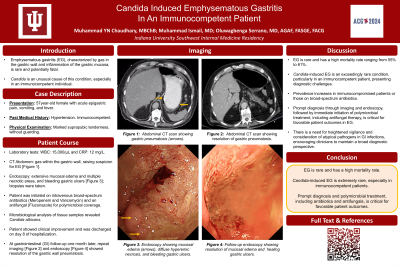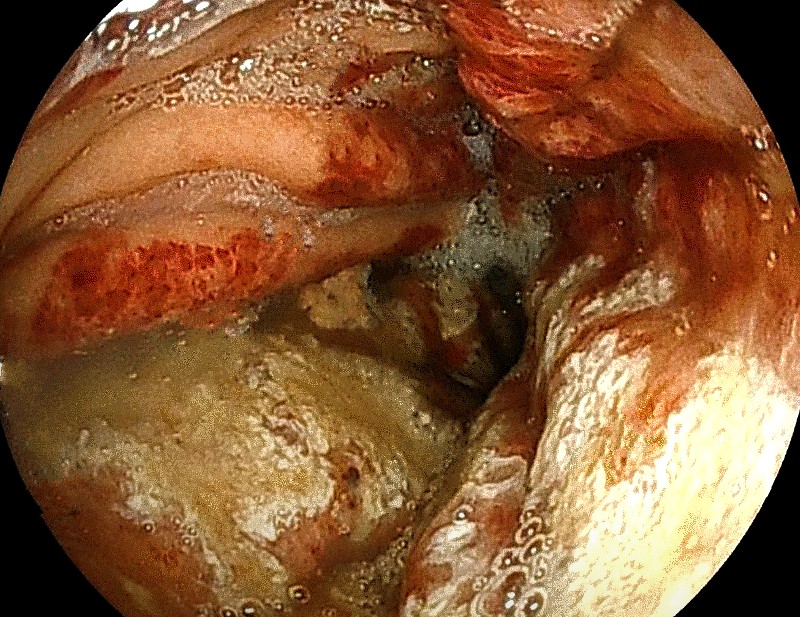Tuesday Poster Session
Category: Stomach
P5116 - Candida-Induced Emphysematous Gastritis: A Case Report
Tuesday, October 29, 2024
10:30 AM - 4:00 PM ET
Location: Exhibit Hall E

Has Audio

Muhammad YN Chaudhary, MBChB
Indiana University Southwest
Evansville, IN
Presenting Author(s)
Muhammad YN. Chaudhary, MBChB1, Muhammad Ismail, MD2, Oluwagbenga Serrano, MD, FACG3
1Indiana University Southwest, Evansville, IN; 2Indiana University Southwest, Cedar Rapids, IA; 3Good Samaritan Hospital, Vincennes, IN
Introduction: Emphysematous gastritis (EG) is a rare and potentially fatal condition characterized by the presence of gas within the gastric wall due to bacterial or fungal infection. Candida species, though a common pathogen in immunocompromised patients, is an unusual cause of this condition. This case report aims to highlight the unique presentation of Candida-induced EG, emphasizing the diagnostic and therapeutic challenges it poses.
Case Description/Methods: A 50-year-old woman with a medical history of hypertension, treated with ramipril, presented to the emergency department with acute epigastric pain, vomiting, and fever. Physical examination revealed marked suprapubic tenderness. Laboratory investigations showed leukocytosis (WBC count: 15,000/µL) and elevated inflammatory markers (CRP: 12 mg/L). Abdominal computed tomography (CT) revealed the presence of gas within the gastric wall, raising suspicion for EG.
Subsequent upper endoscopy demonstrated extensive mucosal edema and multiple necrotic areas in the stomach (Image 1). The patient was promptly initiated on intravenous fluconazole and broad-spectrum antibiotics (meropenem and vancomycin), considering the polymicrobial nature often associated with EG. Microbiological analysis of endoscopic biopsies confirmed the presence of Candida albicans. The patient’s symptoms improved, and follow-up imaging after one month showed resolution of the gastric gas.
Discussion: Candida-induced EG is an exceedingly rare condition, with very few cases reported in the literature. Prevalence increases in immunocompromised patients or those on broad-spectrum antibiotics. The novelty of this case arises from the unusual etiology in a patient without immunosuppression. This showcases the importance of considering fungal infections in differential diagnoses of EG. Early diagnosis and prompt polymicrobial treatment are crucial for favorable outcomes.
This case highlights the utility of combined imaging and endoscopy for diagnosis, and the necessity of early aggressive antifungal therapy. It also contributes valuable insights into the clinical presentation, diagnostic process, and management strategies for this rare condition.This report serves to enhance the existing medical literature on candida-induced EG, emphasizing the need for vigilance in atypical presentations of gastric infections.

Disclosures:
Muhammad YN. Chaudhary, MBChB1, Muhammad Ismail, MD2, Oluwagbenga Serrano, MD, FACG3. P5116 - Candida-Induced Emphysematous Gastritis: A Case Report, ACG 2024 Annual Scientific Meeting Abstracts. Philadelphia, PA: American College of Gastroenterology.
1Indiana University Southwest, Evansville, IN; 2Indiana University Southwest, Cedar Rapids, IA; 3Good Samaritan Hospital, Vincennes, IN
Introduction: Emphysematous gastritis (EG) is a rare and potentially fatal condition characterized by the presence of gas within the gastric wall due to bacterial or fungal infection. Candida species, though a common pathogen in immunocompromised patients, is an unusual cause of this condition. This case report aims to highlight the unique presentation of Candida-induced EG, emphasizing the diagnostic and therapeutic challenges it poses.
Case Description/Methods: A 50-year-old woman with a medical history of hypertension, treated with ramipril, presented to the emergency department with acute epigastric pain, vomiting, and fever. Physical examination revealed marked suprapubic tenderness. Laboratory investigations showed leukocytosis (WBC count: 15,000/µL) and elevated inflammatory markers (CRP: 12 mg/L). Abdominal computed tomography (CT) revealed the presence of gas within the gastric wall, raising suspicion for EG.
Subsequent upper endoscopy demonstrated extensive mucosal edema and multiple necrotic areas in the stomach (Image 1). The patient was promptly initiated on intravenous fluconazole and broad-spectrum antibiotics (meropenem and vancomycin), considering the polymicrobial nature often associated with EG. Microbiological analysis of endoscopic biopsies confirmed the presence of Candida albicans. The patient’s symptoms improved, and follow-up imaging after one month showed resolution of the gastric gas.
Discussion: Candida-induced EG is an exceedingly rare condition, with very few cases reported in the literature. Prevalence increases in immunocompromised patients or those on broad-spectrum antibiotics. The novelty of this case arises from the unusual etiology in a patient without immunosuppression. This showcases the importance of considering fungal infections in differential diagnoses of EG. Early diagnosis and prompt polymicrobial treatment are crucial for favorable outcomes.
This case highlights the utility of combined imaging and endoscopy for diagnosis, and the necessity of early aggressive antifungal therapy. It also contributes valuable insights into the clinical presentation, diagnostic process, and management strategies for this rare condition.This report serves to enhance the existing medical literature on candida-induced EG, emphasizing the need for vigilance in atypical presentations of gastric infections.

Figure: Image 1: Emphysematous changes in the gastric body.
Disclosures:
Muhammad Chaudhary indicated no relevant financial relationships.
Muhammad Ismail indicated no relevant financial relationships.
Oluwagbenga Serrano: MERCK – Stock-publicly held company(excluding mutual/index funds).
Muhammad YN. Chaudhary, MBChB1, Muhammad Ismail, MD2, Oluwagbenga Serrano, MD, FACG3. P5116 - Candida-Induced Emphysematous Gastritis: A Case Report, ACG 2024 Annual Scientific Meeting Abstracts. Philadelphia, PA: American College of Gastroenterology.
